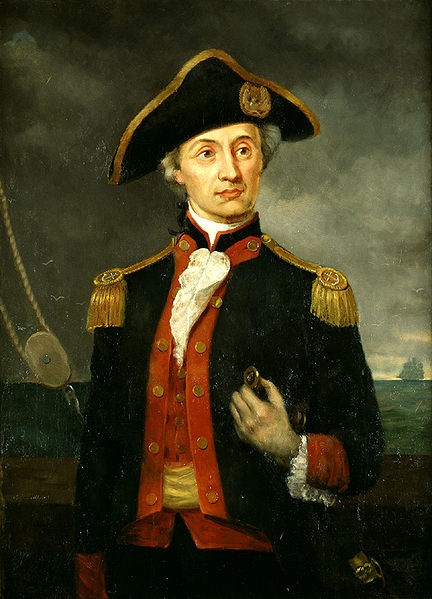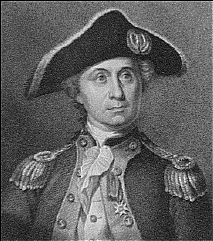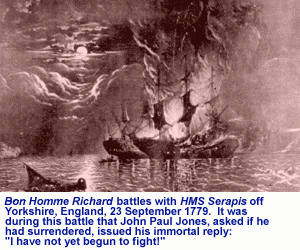 |
| John Paul Jones (wikimedia.org) |
One of the world’s most famous mariners was John Paul Jones. Though born in Kirkcudbrightshire, Scotland, in 1747, he is considered the “Father of the American Navy.” He was a significant figure in the creation of the United States and its powerful navy, and was friends with such noteworthy patriots like: Thomas Jefferson, Benjamin Franklin and Marquis de Lafayette, the Frenchman who helped fight the American Revolution.
Alison Davis Tibbits’ book John Paul Jones gives an in depth account of the life and career of John Paul Jones. He was born on July 6, 1747. He was part of a well-to-do, seven-sibling family, but two of the offspring died in infancy. They lived close enough to the ocean to see ships pass by. From an early age he developed an interest in sailing. His fondness for the sea and adventure led him to join the British Merchant Marines, since his family did not have connections to enable him to begin a career with Great Britain’s Royal Navy. His work included importing and exporting goods all over the world.
He got his job when he was only thirteen years old working as an apprentice for a merchant and ship owner, John Younger from Whitehaven, England, with whom he had a seven year agreement. At first he did menial tasks as a ship’s boy for Captain Robert Benson on the Friendship, earning a small wage. Here he had a place to live while he learned expert seamanship; he could read, write and navigate using the stars. Early on, the Friendship traveled to Virginia; John Paul loved America from his very visit.
 |
After serving three years of his apprenticeship, John Paul was released due to Captain Benson’s financial problems. Following this he worked on two different slave ships, first as a 3rd mate and later as a chief mate. He despised the cruelty and horrible conditions of the slave trade and resigned when the ship was in Jamaica where he boarded his friend’s ship to return home. On his way back to Scotland, both the captain and his first mate died of malaria. With no one onboard with navigating experience, the ship ended up traveling aimlessly. The result was that John Paul navigated the ship safely to Kirkcudbright and at only 21 years old was named captain.
As captain of John, John Paul worked long, exhausting hours. He would buy and sell cargoes of rum, wood, tobacco, spices and other goods in ports along his route. With an unknown seven-man crew, first-impressions were important. He dressed like a gentleman, was well groomed, and tried to set a good example for his crew.
In May 1770, John sailed for its next cruise in Tobago, one of Caribbean’s Windward Islands. About half way to Tobago, the ship’s carpenter, Mungo Maxwell, tried to lead the crew to mutiny. John Paul ended the illegal rebellion and ordered Maxwell to be flogged.
When John landed in Tobago, Maxwell went to the Vice-Admiralty Court, the office that ruled on crimes committed at sea. Maxwell filed a complaint towards John Paul, showing scars to court officials for his maltreatment. When Maxwell’s scars were said “not extreme” by court officials, Maxwell left for home on Barcelona Packet, but died during the voyage due to typhoid fever.
When John returned to Kirkcudbrightshire, a sheriff charged John Paul with Maxwell’s murder and imprisoned him in jail. Because John Paul and almost everyone in Kirkcudbrightshire believed he was innocent, John Paul convinced the court that he would stand trial after he gathered enough evidence to prove his innocence. The courts allowed to be released on bail and gave time to collect the information.
On his way to Tobago in the spring of 1771, John was sold to a different owner and in the process John Paul lost his job. When John Paul reached Tobago, he contacted the captain of Barcelona Packet, the ship Maxwell died on. Both John Paul and the captain confirmed that Maxwell was in good in health when he sailed for London, noting that he became ill and died from fever. When these documents were sent to Maxwell’s mother, she gave them to the court, which accepted them and cleared John Paul’s record.
Putting the false murder charges behind him, John Paul agreed to command a British merchant ship named Betsy during its voyages towards many lands to sell various cargoes. In 1773, Betsy was going through a financial crisis. John Paul promised to pay back the crewmembers in free items in cargoes below deck when he earned extra money. The crew resented the idea. One was outraged. He desperately tried to lead its crew to mutiny by urging the others to demand their wages immediately. John Paul rushed to his cabin and grabbed a sword to end the matter. The troublemaker began swinging a club over John Paul’s head. John Paul thrust forward to defend himself as the man lunged at him, running right into the sword, killing him instantly. John Paul knew word would have out quickly if he didn’t escape right then. So he borrowed a horse, crossed the island and left for Barbados. In doing so, he left behind everything he worked so hard to build-his career, bank account, properties, friends, and business ventures.
From 1773 to 1774, John Paul started a mysterious life in America with the alias of first as “John Jones” and then “John Paul Jones”. He lived very quietly and never discussed his past with anyone.
In 1775, America’s Congress formed the Continental Navy. Jones hoped to join the new navy and was appointed 1st lieutenant of Alfred, one of the first new frigates the Naval Committee had issued. Jones was perfect for his newly appointed job. Most new recruits had no naval experience at all. Jones had a thorough knowledge of seamanship, having learned from the best men of the British Merchant Marine. Jones knew all routes between England and the West Indies, and best of all, he wasn’t afraid of the British. Jones remained on the Alfred until a promotion to captain of Providence in late 1775. Later, Jones began an independent voyage to seize, take, sink, burn, or destroy British ships. Jones was so successful in these operations that he continued to do them on the different ships he later commanded.
 |
| Bon Homme Richard (navy.mil) |
Jones would later take command of various ships including his famous fight with H.M.S. Serapis aboard Bonhomme Richard in 1779. During this fight, Bonhomme Richard was outnumbered, outgunned, heavily damaged and was about to sink any moment. The British asked if Jones would surrender. In response, Jones cried out his famous quote, “I have not yet begun to fight!” In the end, it was the British who surrendered. In that one fight alone, John Paul Jones had proven his bravery and patriotism. He was also very kind to not only his crewmembers, but also his prisoners. He even invited the captain of H.M.S. Serapis to a glass of wine after the fight to show his gratitude for a worthy opponent.
Jones never knew that George Washington granted him American citizenship. After the Revolutionary War, John Paul Jones became ill with pneumonia. He was alone in Paris, France, except for his servant, doctor, and a few friends. On July 18, 1792, John Paul Jones contacted American Ambassador Robert Morris that he was sure he was dying. Jones didn’t want to be with anyone else except for Robert Morris at this time.
Morris, before leaving for a dinner engagement, promised to return at eight o’clock. During his absence, John Paul Jones walked to his bedchamber, lay facedown on the bed, and died. His forty-fifth birthday had passed, unnoticed, twelve days earlier.
John Paul Jones’ legacy still lives on. In 1905, Jones’ coffin was found and identified. His coffin was escorted to America by eleven United Stated Naval ships and arrived in Annapolis, Maryland on April 24, 1906. It was January 26, 1913 when John Paul Jones’ body was moved to a specially designed crypt beneath the Naval Academy’s Bancroft Hall and is currently there today.
John Paul Jones set up the foundation for America’s Navy. Without him, the war could’ve played out differently. Without him, the United States may have not had a navy. Without him, America may have not been here today. America is forever in Jones’ debt, for he have not only created the powerful United States Navy we have today, he also help create the United States itself.
Page created on 12/21/2009 12:00:00 AM
Last edited 12/21/2009 12:00:00 AM
